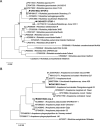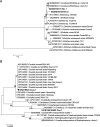Wild Hedgehogs and Their Parasitic Ticks Coinfected with Multiple Tick-Borne Pathogens in Jiangsu Province, Eastern China
- PMID: 36000911
- PMCID: PMC9602733
- DOI: 10.1128/spectrum.02138-22
Wild Hedgehogs and Their Parasitic Ticks Coinfected with Multiple Tick-Borne Pathogens in Jiangsu Province, Eastern China
Abstract
The increasing awareness of emerging tickborne pathogens (TBPs) has inspired much research. In the present study, the coinfections of TBPs both in ticks and their wild hedgehog hosts in Jiangsu province, Eastern China were determined by metagenome next-generation sequencing and nested PCR. As a result, Rickettsia japonica (81.1%), novel Rickettsia sp. SFGR-1 (5.1%), Anaplasma bovis (12%), A. platys (6.3%), novel Ehrlichia spp. Ehr-1 (16%) and Ehr-2 (0.6%), E. ewingii-like strain (0.6%), Coxiella burnetii (10.9%), and a novel Coxiella-like endosymbiont (CLE) strain (61.1%) were detected in Haemaphysalis flava ticks. A. bovis (43.8%), Ehrlichia sp. Ehr-1 (83.3%), and C. burnetii (80%) were detected in Erinaceus amurensis hedgehogs. Coinfection rates with various TBPs were 71.5% and 83.3% in ticks and hedgehogs, respectively, both with double-pathogen/endosymbiont coinfection rates over 50%. We found the following. (i) Er. amurensis hedgehogs seem to contribute to the natural cycles of R. japonica, A. bovis, Ehrlichia sp., and C. burnetii and may be reservoirs of them except for R. japonica, and A. bovis is proved to infect hedgehogs for the first time. (ii) H. flava is proved to harbor various TBPs as a reservoir host, including CLE identified for the first time, which could inhibit coinfection of C. burnetii while promoting that of Rickettsia spp. in H. flava. (iii) Four novel TBP species were identified. This study provides useful epidemiological information crucial for assessing the potential infection risks to humans, thus benefiting the development of strategies to prevent and control tick-borne diseases. IMPORTANCE In the present study, we found the following. (i) Er. amurensis hedgehogs seem to contribute to the natural cycles of R. japonica, A. bovis, Ehrlichia sp., and C. burnetii and may be reservoirs of them except for R. japonica, and A. bovis is proved to infect hedgehogs for the first time. (ii) H. flava is proved to harbor various tickborne pathogens (TBPs) as a reservoir host, including Coxiella-like endosymbiont (CLE) identified for the first time, which could inhibit coinfection of C. burnetii while promoting that of Rickettsia spp. in H. flava. (iii) Four novel TBP species were identified. This study provides useful epidemiological information on TBPs harbored and transmitted by ticks and their hosts, for assessing the potential infection risks to humans, thus benefiting the developing strategies for tick-borne diseases prevention and control.
Keywords: Haemaphysalis flava; Rickettsia; coinfection; hedgehog; mNGS; tick; tick-borne pathogen.
Conflict of interest statement
The authors declare no conflict of interest.
Figures






Similar articles
-
High prevalence of Rickettsia spp. in ticks from wild hedgehogs rather than domestic bovine in Jiangsu province, Eastern China.Front Cell Infect Microbiol. 2022 Jul 26;12:954785. doi: 10.3389/fcimb.2022.954785. eCollection 2022. Front Cell Infect Microbiol. 2022. PMID: 35959365 Free PMC article.
-
Epidemiology of tick-borne pathogens in the semi-arid and the arid agro-ecological zones of Punjab province, Pakistan.Transbound Emerg Dis. 2019 Jan;66(1):526-536. doi: 10.1111/tbed.13059. Epub 2018 Nov 19. Transbound Emerg Dis. 2019. PMID: 30383917
-
Detection of Multiple Intracellular Bacterial Pathogens in Haemaphysalis flava Ticks Collected from Hedgehogs in Central China.Pathogens. 2021 Jan 23;10(2):115. doi: 10.3390/pathogens10020115. Pathogens. 2021. PMID: 33498714 Free PMC article.
-
Global prevalence and species diversity of tick-borne pathogens in buffaloes worldwide: a systematic review and meta-analysis.Parasit Vectors. 2023 Mar 30;16(1):115. doi: 10.1186/s13071-023-05727-y. Parasit Vectors. 2023. PMID: 36998029 Free PMC article.
-
Ticks and Tick-Borne Pathogens of the Caribbean: Current Understanding and Future Directions for More Comprehensive Surveillance.Front Cell Infect Microbiol. 2017 Nov 29;7:490. doi: 10.3389/fcimb.2017.00490. eCollection 2017. Front Cell Infect Microbiol. 2017. PMID: 29238699 Free PMC article. Review.
Cited by
-
Multiple spacer sequence typing of Coxiella burnetii carried by ticks in Gansu, China.Front Vet Sci. 2024 Nov 27;11:1470242. doi: 10.3389/fvets.2024.1470242. eCollection 2024. Front Vet Sci. 2024. PMID: 39664899 Free PMC article.
-
Multiple Ehrlichia chaffeensis genes critical for persistent infection in a vertebrate host are identified as nonessential for its growth in the tick vector; Amblyomma americanum.Front Cell Infect Microbiol. 2023 Jun 27;13:1220025. doi: 10.3389/fcimb.2023.1220025. eCollection 2023. Front Cell Infect Microbiol. 2023. PMID: 37457955 Free PMC article.
-
The epidemiological and infectious characteristics of novel types of Coxiella burnetii co-infected with Coxiella-like microorganisms from Xuyi County, Jiangsu province, China.BMC Infect Dis. 2024 Sep 27;24(1):1041. doi: 10.1186/s12879-024-09924-7. BMC Infect Dis. 2024. PMID: 39333956 Free PMC article.
-
Microbiome diversity in Haemaphysalis flava (life stage-host dependent) and Haemaphysalis longicornis ticks with zoonotic implications in Nantong, China.Acta Parasitol. 2025 Jul 2;70(4):142. doi: 10.1007/s11686-025-01088-x. Acta Parasitol. 2025. PMID: 40601071
-
Serological and molecular screening for zoonotic pathogens among wild hedgehogs (Erinaceus europaeus) from urban areas of Poland.J Vet Res. 2025 Apr 4;69(2):219-226. doi: 10.2478/jvetres-2025-0022. eCollection 2025 Jun. J Vet Res. 2025. PMID: 40552021 Free PMC article.
References
-
- Song K, Ji Y, Sun S, Yue X, Wang C, Luo T, Moming A, Song Y, Zhang Y, Yang R. 2021. Bacterial microbiota in unfed ticks (Dermacentor nuttalli) from Xinjiang detected through 16S rDNA amplicon sequencing and culturomics. Zoonoses 1(1). doi:10.15212/ZOONOSES-2021-0007. - DOI
Publication types
MeSH terms
LinkOut - more resources
Full Text Sources
Medical
Research Materials
Miscellaneous

